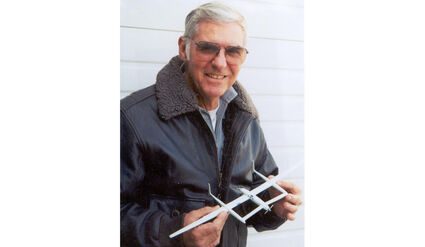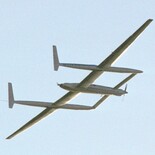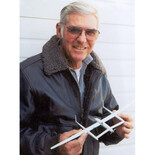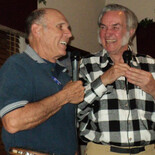Celebrating the 35th anniversary of the epic flight of Voyager
Short Flights
December 4, 2021
There are so many important aviation dates to remember in the month of December. The Wright Brothers' first powered flight was on December 17, 1903, the first glide flight of SpaceShipOne was December 17, 2003, on the 100th anniversary of the Wright Brothers' historic flight and the flight of Voyager between December 14 and December 23, 1986.
The Mojave Transportation Museum's monthly Plane Crazy Saturday event will honor designer Burt Rutan; Command Pilot, Dick Rutan; Pilot Jeana Yeager and Voyager Crew Chief Bruce Evans and the Voyager Volunteers on Dec. 18 at Mojave Air & Space Port. Check http://www.mojavemuseum.org for additional information.
The epic flight of Voyager was a landmark in aerospace history and a testament to the American Spirit. Voyager's flight, with Command Pilot Dick Rutan and Pilot Jeana Yeager, was the first-ever, nonstop, unrefueled flight around the world. This milestone flight took nine days, three minutes and 44 seconds. The absolute world distance records set during that flight remain unchallenged today. To this day, no aircraft has flown more air miles than the Voyager's 26,358 statute miles.
In 2017, the 31st anniversary of the Voyager flight, Dick Rutan spoke at Plane Crazy Saturday at Mojave Air & Space Port. "The flight was based on winds and weather, which is really backwards to all you guys that fly," Rutan said. "Normally you plot your course first, but we couldn't. The Voyager had a feather-light, composite structure with a thin skin and even in very light turbulence the wings would flex and bend. We had meteorologists in the Voyage Command Trailer keeping track of storms and weather for us."
The fragile experimental aircraft weighed 939 pounds and carried more than 7,000 pounds of fuel in its seventeen fuel tanks for the historic nonstop flight around the world. Its gross takeoff weight for the world flight was 9,694.5 pounds, of which 7,011 pounds was fuel. When the flight ended nine days, three minutes and 44 seconds later, only 140 pounds of fuel remained.
"Voyager One, this is Edwards Tower. ATC clears Voyager One from Edwards Air Force Base to Edwards Air Force Base via flight plan route. Maintain 8,000 feet. Cleared for takeoff and Godspeed.
The takeoff, December 14, 1986, was almost catastrophic, as the wings were bending down and the wingtips were dragging on the 15,000-foot runway. The wingtips were severely damaged. Mike and Sally Melvill and Burt Rutan were flying in a Duchess aircraft nearby and Mike informed Dick that he would have to get rid of the damaged winglets.
Dick applied the right rudder to sideslip the aircraft in an effort to make the winglet release. After trying a second time, the winglet fluttered away and the left winglet came off a short time later. There were fears that the winglets tearing off might cause damage to the fuel cells in the wings, but they did not.
The second day, Dec. 16, was spent dodging Typhoon Marge and the bands of storms between Wake Island and the Marshall Islands. They made their way through a wall of weather and actually picked up a tailwind.
By day four, they were half way around the world over Sri Lanka. When the Voyager crew called Air Traffic Control (ATC), they asked the routine questions: what type aircraft, point of origin and destination. Rutan replied type of aircraft was Voyager, flight originated KEDW (Edwards) and destination KEDW (Edwards). ATC didn't believe they were on a world flight and admonished the pilots for such a story. After that experience, Rutan requested that all communication with ATC's would be handled by the folks in the Voyager Command Trailer in Mojave. "Our phone bill was really high with all of the long distance phone calls," remarked Rutan.
Later that day, Voyager broke the absolute world distance record of 12,532 statute miles that had been set by a B-52 in 1962.
Dick recalled looking down and seeing a long beautiful runway and remembered thinking, oh how nice it would be to land and be able to sleep. But he heard a voice in his head saying, "If you can dream it, you can do it. The only way to fail is to quit!" The voice was that of his mother, Irene Rutan. He said, "I knew we had to keep going."
During this milestone flight, they navigated around terrible weather and thunder storms, avoided hostile countries threatening to shoot them down, worried about having enough fuel (most of the time running only one of the two engines to conserve fuel), and suffered with sleep deprivation.
After resolving various mechanical issues, this intrepid team was on the last leg of the flight. Flying near the tip of the Baja Peninsula at night, they were transferring fuel when the electrical transfer pump failed. The rear engine coughed and stopped running, due to an air bubble in the line. Exhausted, the two pilots had to deal with another life-threatening problem. The rear propeller was windmilling and creating drag, however the windmilling was the only way to start that engine if they could get the fuel to flow again.
Mike Melvill's calm voice from Mojave encouraged Rutan to start the front engine, the only engine with a starter. When they were only 3,500 feet over the water the front engine came to life and as they leveled out, fuel had run to the rear engine and it was running, too. They leaned the front engine as much as possible, but left it running. There was concern about using more fuel, but fear and tribulation turned into joy when airliner pilots started sending them radio messages of congratulations as they were passing near San Diego.
Just south of Los Angeles, Burt Rutan and the Melvills in the Duchess, met up with Voyager. As they entered into the airspace over the Antelope Valley, Rutan called Edwards tower and was shocked to learn that the Air Force had cancelled all operations just waiting for their return. "I couldn't believe that they would cancel all flight operations for us little 'homebuilders' from Mojave," Rutan said.
On December 23, 1986 at 7:32 a.m. Voyager entered the edge of the restricted airspace and saw the dry lake where they would be landing. They flew over the thousands of people who came to witness the landing, making several circuits in the sky with chase planes before landing at 8:05 a.m.
The impressive round-the-world flight marked the 69th flight of Voyager and launched Dick Rutan and Jeana Yeager into aviation history forever. The absolute world distance records set during that flight remain unchallenged today. The flight was sanctioned by FAI (Fédération Aéronautique Internationale).
Four days after landing, President Ronald Reagan presented the Voyager crew and its designer with the Presidential Citizenship Medal. Awarded only 16 times previously in history.
For their record-breaking flight, the pilots, Dick Rutan and Jeana Yeager, the designer, Burt Rutan, and the crew chief, Bruce Evans, earned the Collier Trophy in 1986, aviation's most prestigious award.









